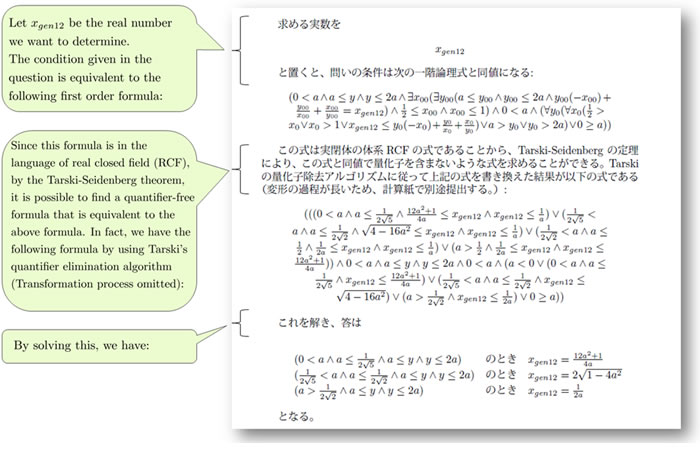Tokyo and Kawasaki, Japan, November 25, 2013
Fujitsu Laboratories Ltd. and Japan's National Institute of Informatics (NII) announced today that under NII's "artificial brain" project, known as "Todai Robot Project - Can a Robot Pass the University of Tokyo (Todai) Entrance Exam?," for short, their entry has taken a practice exam held by Yoyogi Seminar - Education Research Institute, a leading Japanese preparatory school.
Under the Todai Robot project, Fujitsu Laboratories has been conducting joint research and participating as the core members of the math team. The overall project, led by NII professor Noriko Arai, commenced in 2011 with the goal of enabling an artificial brain to score high marks on the test administered by the National Center for University Entrance Examinations by 2016 (the "Center Test"), and crossing the threshold required for admission to the University of Tokyo by 2021.
Based upon results of research to date, this year the project took on the challenge of practice exams conducted by Yoyogi Seminar. The math team covered content that could be found on the Center Test (Math IA, Math IIB) and the University of Tokyo entrance exam pre-tests for humanities course and sciences course. For language processing of the text of the exam questions, a certain amount of human intervention was allowed. As for results, the artificial brain of Todai Robot automatically solved two out of four University of Tokyo math questions for humanities course, and two of six math questions for science course. Among all exam takers for humanities and sciences, the results represented a deviation value of approximately 60.
This attempt at an actual practice test serves to evaluate the progress of research results to date, and to identify technical issues to be addressed by future research and development work.
Tokyo Shoseki Co., Ltd. and JC Educational Institute, Inc. kindly provided mathematics problems as part of the mathematics research for Todai Robot project.
Fujitsu Laboratories is involved in the Todai Robot math team, in collaboration with NII, to develop the technologies needed to bring about Fujitsu's vision of a Human Centric Intelligent Society. The goal is to make calculation technology more robust so as to accurately solve a variety of math problems, such as for mathematical analysis and optimization technology, and to automate advanced mathematical analysis for real-world problem solving.
For more information on the Yoyogi Seminar practice test challenge, please see the Todai Robot website at http://21robot.org.
The research initiatives of the math team have been introduced in the collection of papers for the 27th Annual Conference of the Japanese Society for Artificial Intelligence, 2013, as "Solving University Entrance Exam Math Problems through the Integration of Deep Language Understanding and Computer Algebra," (Takuya Matsuzaki, Hidenao Iwane, Hirokazu Anai, Akiko Aizawa, and Noriko Arai), and "A Symbolic Approach to University Entrance Examination Problems in Mathematics and Issues Combining with National Language Processing," (Hidenao Iwane, Takuya Matsuzaki, Hirokazu Anai, and Noriko Arai).
Technological Issues
For a computer to solve math entrance-exam problems, it must first convert the problem text, which is expressed in natural language and formulas meant to be easily understood by humans, into a form that a program can execute. The next step is for a program known as a "solver" to solve the problem. This requires three processes.
1. Language processing & semantic analysis: Understand the problem text, which is expressed as natural language and formulas easily understood by humans. More specifically, translate the problem text into a formalized semantic representation.
2. Formulation: Transform the semantic representation of the problem into a form amenable to automatic deduction. In short, convert it to a form that the computer can process.
3. Calculation: Find the answer using the mathematical solver.
Fully automating the language processing and semantic analysis part is not easy. The processing in Step 1 consists of the following three components:
1-a: Recognize the grammatical relationships between individual words (parsing).
1-b: Compose a semantic representation of the sentence based on semantic representations of the words (semantic composition).
1-c: Recognize the logical relationships between sentences(contextual analysis).
Work still remains to be done on each of these steps before full automation is achieved. The Yoyogi Seminar practice test challenge allowed for partial human intervention in the parsing and contextual analysis, but the rest was processed automatically.
The bridge to the mathematical solver is a formula based on the semantic representation of the problem text drawn from natural-language processing. However, this formula is often much more redundant than what is expressed by humans. Work still remains to be done on creating simpler formulas and making the solver faster and more efficient. It will also be important to develop calculation algorithms for the solver that are specifically tuned to entrance-exam problems.
In short, there is more theoretical and technical work to do on each step, and different technologies will need to be combined in different ways to solve different kinds of problems.
 Figure 1: The Todai Robot's answer sheet for the University of Tokyo entrance exam pre-test
Figure 1: The Todai Robot's answer sheet for the University of Tokyo entrance exam pre-test
Future Initiatives for the Math Team
The Yoyogi Seminar challenge has brought some issues to light. There are some words that Todai Robot did not know, so the mathematics dictionary and knowledge base are being expanded, and the next milestone is to fully automate the parser and contextual analyzer.
Also, to handle a wider range of problems, the semantic analysis and calculation steps both need to be developed further. Research and development are underway to find more sophisticated techniques for representing problems through semantic interpretation and for the stages in the calculations. This is helping to reduce the time required for calculations by the automatic solver and problem domains that the system currently cannot handle.
![]() E-mail: arai@nii.ac.jp
E-mail: arai@nii.ac.jp![]() E-mail: trobo@ml.labs.fujitsu.com
E-mail: trobo@ml.labs.fujitsu.com![]() E-mail: kouhou@nii.ac.jp
E-mail: kouhou@nii.ac.jp